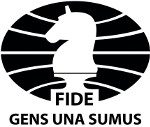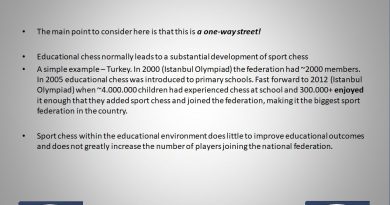The Fourth Chess in Education Lecturer course. 15-17 April 2022
The I nternational Chess Federation, together with its Chess in Education Commission (EDU) and “Chess” Scientific Research Institute (CSRI), is pleased to announce the 4th Chess in Education Lecturer course. The course will be held 15-17 April, in English, online 15:00-20:00 CET.
nternational Chess Federation, together with its Chess in Education Commission (EDU) and “Chess” Scientific Research Institute (CSRI), is pleased to announce the 4th Chess in Education Lecturer course. The course will be held 15-17 April, in English, online 15:00-20:00 CET.
The objectives of the course:
- Develop and enhance the skills of effective teaching of chess basics,
- Enhance the ability of using active and interactive teaching methods,
- Improve positive professional communication skills.
Target audience of the course is professionals with experience in chess and education.
Duration and content: 3 days – 15 hours (including breaks) + Project.
Day 1
- Introduction (100 minutes); Fear – both teachers’ fear and your fear of exam!
- Teaching the chessboard. (130 minutes)
- Project assignment (10 minutes)
Day 2
- Interdisciplinary chess & educational chess (10 minutes)
- Chessmen: values, moves and set up (115 minutes)
- Check. Mate. Stalemate. (115 minutes)
Day 3
- Presentation of assignments (The projects are not presented. Participants need to send it by email).
- Problem solving skills. Teaching playing skills (120 minutes)
- Effective teaching skills and Course summary (75 minutes)
- Exam (45 minutes)
The cost of training is €75, which covers both access to materials and preparation, and the exam.
Those who successfully pass the course will receive the diploma of Certified FIDE Chess in Education Lecturer (CEL). This is valid for three years, and it implies an administrative fee of €50.
Applications for the course are open till April 13. If you want to apply, please fill in the Registration form for “Preparation of Lecturers” and send it to edu.chairman@fide.com & copy to edu.senioradviser@fide.com. Your CV & Motivation letter should pay special attention to your relevant experience in “educational chess”, rather than “sport chess” (please check this explanatory document if you are unsure about the difference between these two concepts.
The course is limited to a maximum of 20 people (first come, first served). Applicants who cannot be given an assured place will be placed on the waiting list for the subsequent course.

